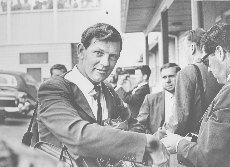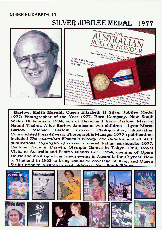Keith Barlow
Where have you worked and over what time period?
I became a copyboy at Australian Consolidated Press in 1950 and remained with ACP for almost 42 years. I became a cadet after two years as a copy boy with the Sydney Daily Telegraph. After my four year cadetship I was made redundant. I then worked at the CSIRO for a year. I was re-employed by ACP and worked as a staff photographer at the Australian Women’s Weekly from 1959 until 1989. I was the photographic manager at the Weekly from 1979 to 1989. In 1989 I was retrenched and worked at the Sydney Daily Mirror, a News Ltd newspaper, in the radiogram room. In 1994, I left News Ltd at sixty and worked for a car company until 1999.
How did you get into press photography - what was your big break?
I applied for a position as a copy boy when I was fourteen and I became a cadet in 1950. I fell in love with photography as a young boy. It was absolute magic and I couldn't believe that I could do anything else but become a photographer.
What is your favourite photograph of all those you have taken and why?
The ‘riddle of the rooster on the raft’ was my favourite photograph, taken during the flooding of Riverstone in December 1961. I hired a little rowing boat and went out. I couldn't believe it when, floating on a door or piece of wood, I saw a rooster and an egg. I took a photograph and managed to save the rooster but the egg rolled into the water. I also took a picture of the rooster next to a sign showing how deep the water was. When the pictures were developed, Esme Fenston, the editor of the Australian Women’s Weekly rang and asked if the first one was a fake picture and if I put the egg there. She said she couldn't use it because there'd be too much controversy about how the egg got there. The Weekly used the second picture instead. I asked if I could send the original picture overseas and Miss Fenston gave me permission. I sent it to Life magazine and they used it full page. An American advertising agency wrote to me later and asked if they could use the image, for a price. They wrote an insurance advertising campaign, 'Don't put all your eggs in one basket.’ That picture was never published in Australia.
What is the biggest change you've seen in press photography over your career?
The change in cameras was the most significant shift, in addition to the improvement in the speed of film. We had to use slow shutters. The film had a low speed relaying to about 10 or 12 ASA. This increased and a tripod had to be used to accommodate the slow shutter speed. The speed slowly improved up to about 500 ASA. The difference this meant for taking sporting photos was tremendous.What was the first camera you used and what camera do you use now?
As a cadet we would borrow a camera from one of the senior photographers and go to Hyde Park and try to get a good picture. The cameras we used were a Graflex or an old fashioned Speed Graphic. The last camera I used was an Olympus 35 mm.

